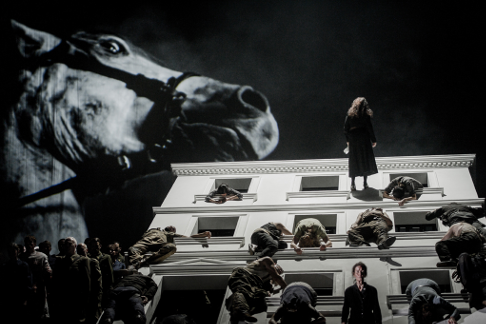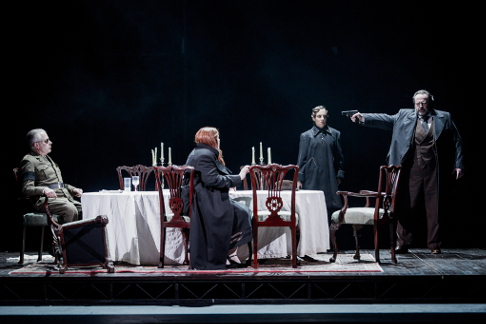14 Nov 2015
Calixto Bieito’s The Force of Destiny
The monochrome palette of Picasso’s Guernica and the mural’s anti-war images of suffering dominate Calixto Bieito’s new production of Verdi’s The Force of Destiny for English National Opera.

The monochrome palette of Picasso’s Guernica and the mural’s anti-war images of suffering dominate Calixto Bieito’s new production of Verdi’s The Force of Destiny for English National Opera.
Seated at a grandiose table, a black silhouette, swirled in mist, is suddenly illuminated by blazing white light, next framed by a towering triangle of light whose tip points upwards like an aspiring cathedral tower (lighting design by Tim Mitchell). But, we are in a world wrenched by violence and chaos, and the Church will offer no consolation or salvation. Bieito’s milieu is Spain, during the Civil War: the only brief flashes of colour are provided by the waving of the red-yellow nationalist flag and the shedding of blood.
It’s also a world that Bieito feels close to: born in northern Spain’s Miranda de Ebro in 1963, Bieito tells us, in a programme note, of his grandmother’s stories of ‘shots being fired behind the cemetery walls as she lay in her bed at night […] every morning she would be greeted by the same scene: a pile of dead bodies in the forecourt by the wall’. Her ‘terrible stories’ are invoked by the production’s visual imagery. Upon the white, balconied façades which border the public square — then swivel, slide and tilt to form depressing back-alleys and fire-escapes — contemporary newsreels of marching armies, public protests and the wailing distress of a dying child are projected. Alongside them, Picasso’s icons of pain and anguish tell their own story: agonised faces, severed limbs, gaping wounds, a horse falling in agony, the bare lightbulb of a torturer’s cell (video designs by Sarah Derendinger).
Updating Verdi’s opera to the years of the Spanish Civil War makes sense. Both Picasso and Verdi employ a big canvas; and, the cover-image of the ENO programme — a sword up to its hilt in blood and casting a crucifix-shadow on an ochre wall — may allude to the toxic tensions between the Catholic hierarchy and the Republic, and the Church’s role in adding fuel to the flames when conflict broke out.
But, the drama of Verdi’s opera hinges on the private and not the public world; specifically the triangle formed by Leonora, her beloved Alvaro, and her vengeful brother Carlo di Vargas. Here, Bieito’s touch is less sure. The static nature of the thought-provoking images he and his designer, Rebecca Ringst, present ultimately hinders the dramatic currents that Verdi’s score articulates. We are presented with photographic snap-shops but these do not come alive to form a tragic narrative. The ENO chorus, in tremendous voice, stand and deliver. Even the principals seem barely to communicate; all the relationships are dysfunctional. In the opening scene Leonora and her father, the Marquis of Calatrava, sit at the table, immobile, paralysed by patriarchal disapproval and oppression. During the impassioned duets — for Alvaro and Leonora in Act 1, and Alvaro and Carlo in Act 3 — the protagonists’ emotions are sung but not dramatized.
There are no assassins from whom Alvaro may rescue Carlo. And, there is no sign of army life or military action. When Alvaro sings of his misery in his Act 3 aria, ‘La vita è inferno all’infelice’, he appears, not among his fellow troops but poking through, and isolated by, the gaping window of one of the sloping façades. He is later joined, in another window frame, by the surgeon — whose white apron might have been stained as much by blood from the abattoir as from the battlefield. The only thing that moves is the scenery: and even this paradoxically hindered the momentum when, after Carlo and Alvaro had dashed off to fight their duel, a lengthy pause intervened as the stage-hands struggled to re-position the façades, forcing Leonora to put her great prayer for peace, ‘Pace, pace mio Dio!’, on hold.
 Scene from The Force of Destiny
Scene from The Force of Destiny
The significance of some of Bieito’s smaller gestures was not immediately fathomable. Why, when she crouches over her father’s dead body in the opening Act, does Leonora remove his belt? What does the image of a girl scribbling on a blackboard — which is projected onto the front-cloth during the second interview — portend? On the other hand, the symbolism of some motifs is heavy-handed: Don Carlo’s Act 2 aria, in which he pretends to be a student from Salamanca named Pereda, was ‘sabotaged’ by the noisy shredding of books by the peasant crowd — an allusion, one presumes, to the burning by Franco’s troops in 1939 of the entire library of Pompeu Fabra, who had dedicated himself to the study of the Catalan language — an act of cultural vandalism which was accompanied by cries of ‘Abajo la inteligencia!’ (Down with intelligentsia!)
The directorial gestures leave us in no doubt, though, of the cruelty of the world depicted. In Act 3, Preziosilla’s ‘Rataplan’ hymn of praise to military life becomes an incitement to brutality: the soldiers oblige by executing some of the starving refugees, while Preziosilla indulges her own bloodlust by savagely kicking a pregnant woman. Fra Melitone’s chastisement of their godlessness feels ineffectual and impotent in the face of such depravity. On becoming a hermit, Leonora is crowned with a barbed wire laurel — with which she later chokes herself.
If the human relationships between the protagonists interest Bieito less than abstract notions of fanatical hatred and passion, then the singers still create compelling portraits. As Alvaro, Gwyn Hughes Jones demonstrated a gallant Verdian power: in Jeremy Sams’ rather clunky and mundane translation, Alvaro sings of a ‘fiery beacon’ and ‘glory and splendour’ in his Act 1 aria, apposite terms for Hughes Jones’s vocal heroism. However, it didn’t always feel comfortable: he reached the top, but the effort required was evident, and Hughes Jones’s tone and intonation lost focus in some of the quieter passages.
Anthony Michaels-Moore convincingly portrayed Carlo’s bitter, obsessive vengefulness. This was a well-judged performance: Michaels-Moore took command of the stage at the start of Act 4 when Carlo forces Alvaro to fight. Throughout he used his baritone expressively, and employed a range of colours which conveyed Carlo’s private torments.
The real star, though, was American soprano, Tamara Wilson, making her role debut as Leonora and her first appearance in the UK. She has a magnificent voice, a gleaming lirico-spinto which can soar with enormous power at the top but which also has richness, depth and hints of darkness at the bottom. Able to modulate the dynamics with sure control, Wilson rode the dramatic climaxes with ease, effortlessly ascending above and cutting through the orchestra. Her intonation was unfailingly true, and in Act 1 Leonora was tender and vulnerable. Wilson brightened her soprano in the monastery scene, floating above the monks’ chanting, perhaps intimating hope; but she saved her best for a resplendent ‘Pace, pace, mio Dio!’ in the last Act.
 Matthew Best as Marquis of Calatrava, Tamara Wilson as Donna Leonora di Vargas, Clare Presland as Curra, and Gwyn Hughes Jones as Don Alvaro
Matthew Best as Marquis of Calatrava, Tamara Wilson as Donna Leonora di Vargas, Clare Presland as Curra, and Gwyn Hughes Jones as Don Alvaro
Rinat Shaham’s Preziosilla was feisty and vivacious, and Andrew Shore — who is coming to the end of his run as Bartolo’s in ENO Barber of Seville — swapped comic foolishness for ecclesiastical menace and, as a petulant Fra Melitone, found some surprisingly dark baritonal tones. He was effectively complemented by James Cresswell’s mellifluous and well-projected Padre Guardiano. Replacing the indisposed Matthew Best, Robert Winslade —Anderson sang the short role of the Marquis of Calatrava with a firmly supported bass-baritone; when accidentally shot by Alvaro, he slid with impressive melodrama to the floor, dragging table-cloth and candelabras with him.
Conductor Mark Wigglesworth chose to perform Verdi’s original, shorter Overture. During the evening, he drew playing of tremendous vigour and strength from the ENO orchestra, moving swiftly through the score — sometimes thwarting the audience’s desire to applaud individual arias — and injecting momentum which went some way to compensate for the lack of movement on stage.
Overall, Bieito presents many arresting moments but they are not connected by a sustained dramatic thread and this weakens the impact of the score’s own dramatic persuasiveness. The director cites Antoine Saint-Exupéry: ‘Civil war is not war, but disease. The enemy is internal, people fighting themselves.’ Perhaps that is why Bieito has decided that Leonora should take her own life, rather than die at the hands of the mortally wounded Carlo who, in Piave’s libretto, stabs her as bends over his body. But, in so doing — and though Carlo sings, ‘I am weary of this struggle with fate’ — Bieito denies us a revelation of the tragic force of destiny.
Claire Seymour
Cast and production information:
Don Alvaro: Gwyn Hughes Jones, Donna Leonora di Vargas: Tamara Wilson, Don Carlo di Vargas:Anthony Michaels-Moore, Padre Guardiano: James Creswell, Fra Melitone: Andrew Shore, Preziosilla: Rinat Shaham, Marquis of Calatrava: Robert Winslade Anderson, Curra: Clare Presland, Trabuco: Adrian Dwyer, Alcade: Nicholas Folwell; Director: Calixto Bieito, Conductor:Mark Wigglesworth, Set Designer: Rebecca Ringst, Costume Designer: Ingo Krügler, Lighting Designer: Tim Mitchell, Video Designer: Sarah Derendinger, Orchestra and Chorus of English National Opera. English National Opera, London Coliseum, Monday 9th November 2015.